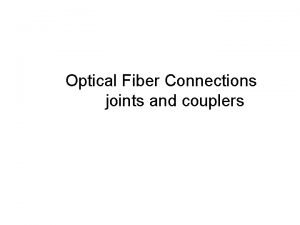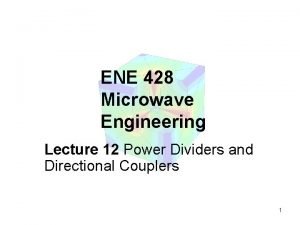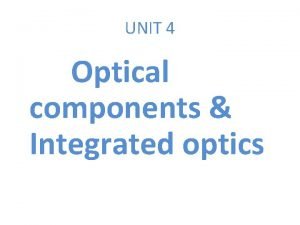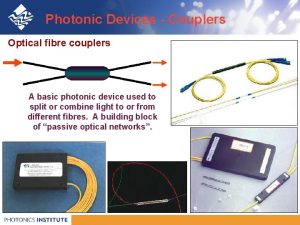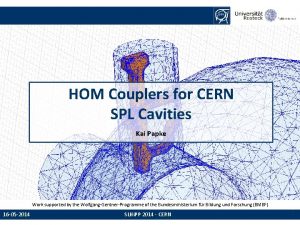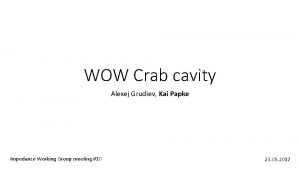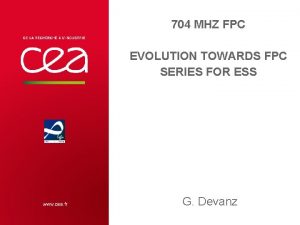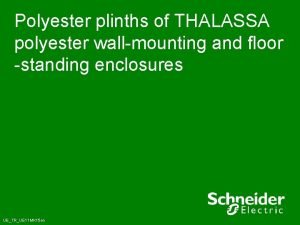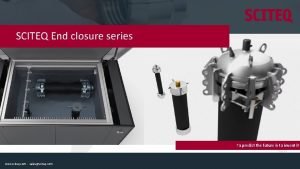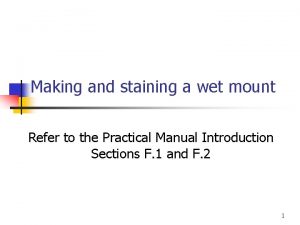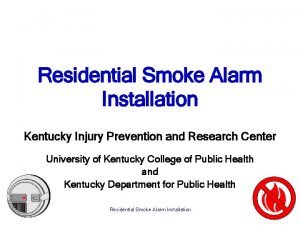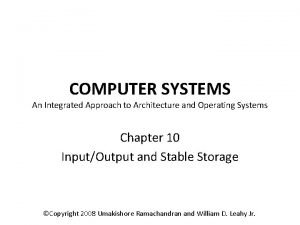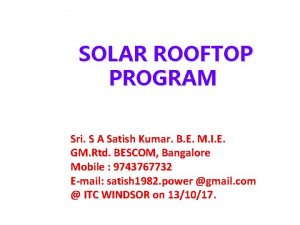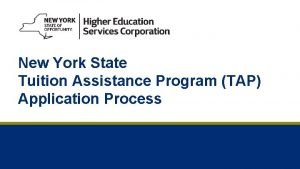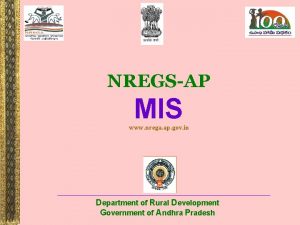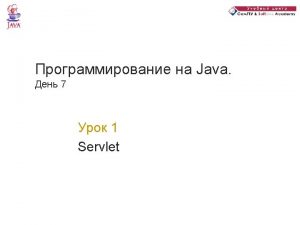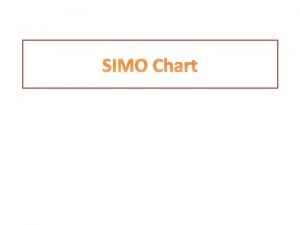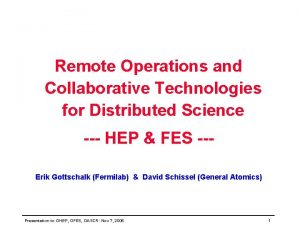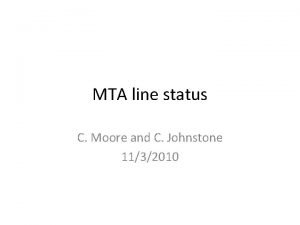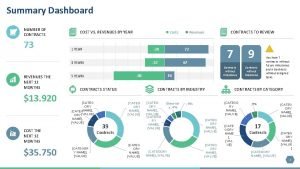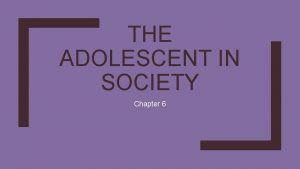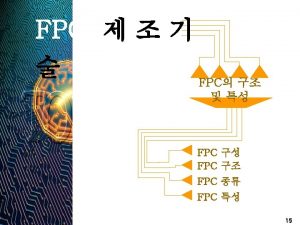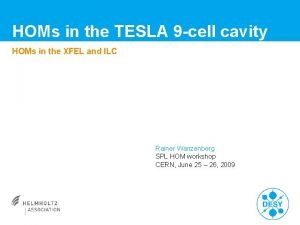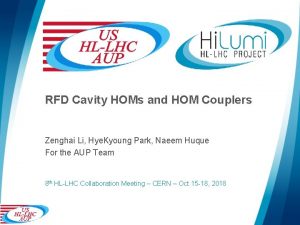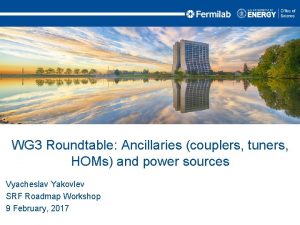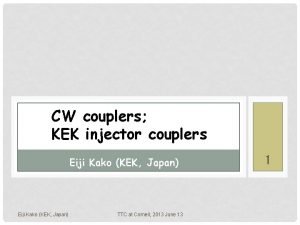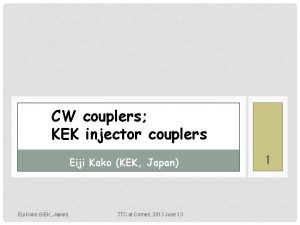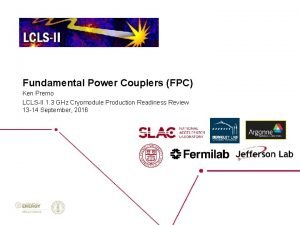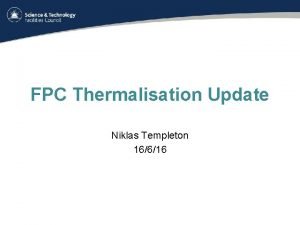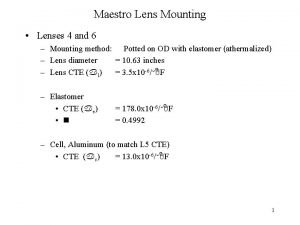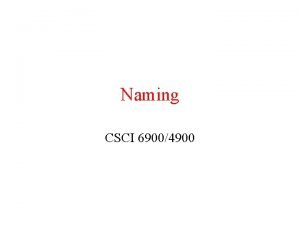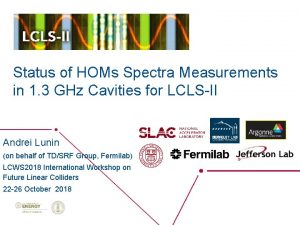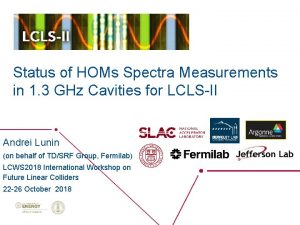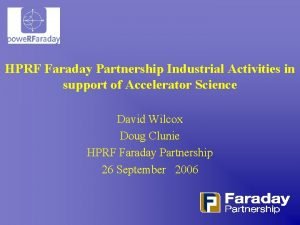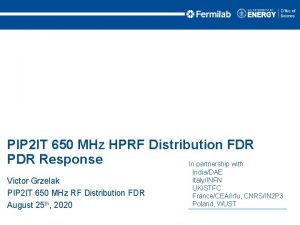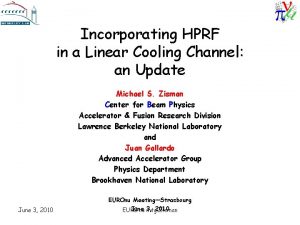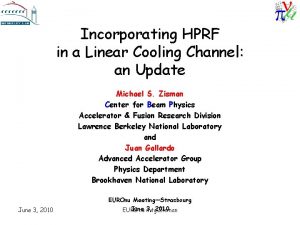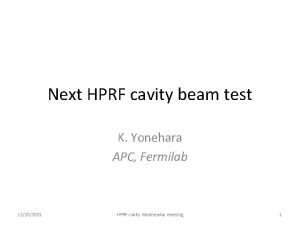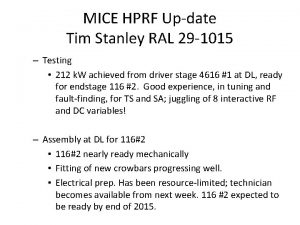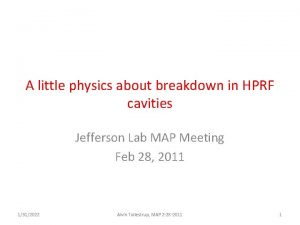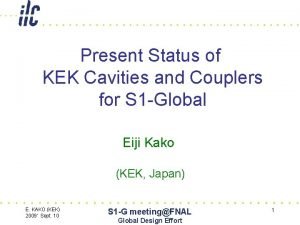FPC HPRF status Couplers mounting FPC HOMS FA






























- Slides: 30

FPC & HPRF status Couplers mounting (FPC, HOMS & FA) Eric. Montesinos@cern. ch on behalf of many colleagues involved in the project International Review of the Crab Cavity Performance for Hi. Lumi, CERN, Geneva, 03 -05 April 2017

Glossary SPS Super Proton Synchrotron, the second-largest machine in CERN's accelerator complex, in service since 1976, measuring nearly 7 kilometres in circumference BA Batiment Auxiliaire, Surface building of the SPS LSS Long Straight Section, underground sector of the SPS LS Long Shutdown YETS End of the Year Technical Stop EYETS Extended End of the Year Technical Stop FPC Fundamental Power Coupler, Main Power Coupler HOMS High Order Mode Suppressor FA Field Antenna SSPA Solid State Power Amplifier IOT RF tube amplifier HVPS High Voltage Power Supply Cubicle RF transmitter including IOT, HVPS, SSPA and controls HPRF High Power Radio Frequency system including Cubicle, transmission lines, circulator and loads Eric. Montesinos@cern. ch, International Review of the Crab Cavity Performance for Hi. Lumi, CERN, Geneva, 03 -05 April 2017 2

Mandate (from a quick email guideline from WP 4 leader) A quick recap of the design choices for the FPC and HPRF, and why this is a good choice for the LHC The test results for the FPC and for the IOT HPRF Status of the HPRF procurement & installation in BA 6 and in LSS 6 Assembly of the FPC, HOMS & FA in the near future FPC Cryo module Controls Any critical items and challenges as you see today both for SPS and LHC LLRF I was reminded by Lucio that this review is a "management" review with technical contents, so not too many technical details Eric. Montesinos@cern. ch, International Review of the Crab Cavity Performance for Hi. Lumi, CERN, Geneva, 03 -05 April 2017 3

Outline Schedule and design choices for the HPRF & for the FPC LHC Summary Conclusion Eric. Montesinos@cern. ch, International Review of the Crab Cavity Performance for Hi. Lumi, CERN, Geneva, 03 -05 April 2017 4

Preamble – purchasing rules We always try to contact a minimum of one company per member state Minimum ONE year from announcement to Contract Start Date Once we decide on technical parameters, very difficult to modify the choices whilst keeping the schedule constrains For small series One year to place the order One year to build the device (a minimum with high power RF systems) Half a year to commission the device Two and a half years from technical decision to operation Eric. Montesinos@cern. ch, International Review of the Crab Cavity Performance for Hi. Lumi, CERN, Geneva, 03 -05 April 2017 5

High Power RF & Fundamental Power Coupler 2013 2014 LS 1 2015 2016 2017 2018 2019 2020 2021 LS 2 Run 2 2022 Run 3 2024 2025 LS 3 2026 2027 2028 Run 4 Successful story of a moving target planning SPS prototype beam tests CM 1 CM 2 LHC pre-series LHC series & installation Thanks to the always moving planning we have been able to propose very good technical choices Eric. Montesinos@cern. ch, International Review of the Crab Cavity Performance for Hi. Lumi, CERN, Geneva, 03 -05 April 2017 6

High Power RF & Fundamental Power Coupler 2013 2014 LS 1 2015 2016 2017 2018 2019 2020 2021 2022 LS 2 Run 3 Run 2 2 2023 2024 2025 LS 3 2026 2027 LHC Crab Cavity Engineering Meeting, FNAL, Dec 2012 2028 Run 4 4 SPS prototype beam tests CM 1 CM 2 HPRF 40 k. W CW @ 400 MHz Inner cooling tube FPC Three possible designs Inner line outer Ø = 27 mm Outer line inner Ø = 62 mm SPS tests to start in 2016 in LSS 4 RF power amplifier Eric. Montesinos@cern. ch, International Review of the Crab Cavity Performance for Hi. Lumi, CERN, Geneva, 03 -05 April 2017 7

High Power RF & Fundamental Power Coupler 2013 2014 LS 1 2015 2016 Run 2 2017 2018 2019 LS 2 2020 2021 2022 2023 Run 3 2024 LS 3 2025 2026 2027 2028 Run 4 Crab Cavity Workshop, CERN, Dec 2013 SPS prototype beam tests CM HPRF Re-use the Tetrode amplifiers that have been in operation in the SPS from 1996 to 2000 Four units 50 k. W @ 352 MHz One unit 40 k. W @ 400 MHz For the Crab programme, we intended to build Two systems for the BA 4 (SPS test) Two systems for the SM 18 (qualification) The HVPS of the SPS SUPRA project from 1996 to 2000 On the left, the 352 MHz 50 k. W CERN Tetrode amplifier Eric. Montesinos@cern. ch, International Review of the Crab Cavity Performance for Hi. Lumi, CERN, Geneva, 03 -05 April 2017 8

High Power RF & Fundamental Power Coupler 2013 2014 LS 1 2015 2016 2017 Run 2 2018 2019 LS 2 2020 2021 2022 2023 Run 3 2024 LS 3 2025 2026 2027 Run 4 2028 Crab Cavity Workshop, CERN, Dec 2013 SPS prototype beam tests CM HPRF As we will have to operate full reflection, we also need a circulator to protect the IOT We decided to purchase LHC circulators and loads Will be LHC spares after the SPS test Rated 330 k. W for almost the same cost as a new development for 50 k. W unit The SPS table, seen from the HPRF side Two flexible coaxial lines connected to the circulators, the loads (reduced length compare to LHC for integration reasons), and the WG to the FPC on top of the cryomodule Eric. Montesinos@cern. ch, International Review of the Crab Cavity Performance for Hi. Lumi, CERN, Geneva, 03 -05 April 2017 9

High Power RF & Fundamental Power Coupler 2013 2014 LS 1 2015 2016 2017 Run 2 2018 2019 LS 2 2020 2021 Run 3 2022 2023 2024 2025 LS 3 2026 2027 2028 Run 4 Crab Cavity Workshop, CERN, Dec 2013 SPS prototype beam tests CM FPC To our experience a FPC project from design to tests, takes minimum from three to five years Due to the very tight schedule, we decided to build FPC based on the recent successful SPL design The SPL test bench at CEA We successfully tested FPC up to 1 MW full reflection at all phases Eric. Montesinos@cern. ch, International Review of the Crab Cavity Performance for Hi. Lumi, CERN, Geneva, 03 -05 April 2017 10

High Power RF & Fundamental Power Coupler 2013 2014 LS 1 2015 2016 2017 2018 2019 LS 2 Run 2 2020 2021 Run 3 2022 2023 2024 2025 LS 3 2026 2027 Run 4 2028 Crab Cavity Workshop, CERN, Dec 2013 SPS prototype beam tests CM FPC The FPC design is with Titanium flange AL 2 O 3 - 97. 6% disk ceramic (increased ceramic diameter from 100 to 125 mm) 3 D forged OFE Copper outer line Coaxial to Wave Guide transition without doorknob Inner line inner with water cooling (exception to CERN’s rule) as hook is in the high B-field region The FPC design had to be compatible with three different possible options DQW (Double Quarter Wave Resonator) RFD (RF dipole) 4 Rods Eric. Montesinos@cern. ch, International Review of the Crab Cavity Performance for Hi. Lumi, CERN, Geneva, 03 -05 April 2017 11

High Power RF & Fundamental Power Coupler 2013 2014 LS 1 2015 2016 2017 Run 2 2018 2019 2020 LS 2 2021 2022 2023 Run 3 2024 LS 3 2025 2026 2027 2028 Run 4 SPS prototype beam tests CM HPRF June 2014, one SPS SUPRA unit successfully tested up to 45 k. W CW @ 400 MHz Launch the order of six tetrodes Old HVPS have shown to be out of age, started the purchasing process of a new HVPS The old complete SPS SUPRA system restarted in 2013 -2014 in our test bench On the front, the CERN amplifier based on a TH 571 B tube Eric. Montesinos@cern. ch, International Review of the Crab Cavity Performance for Hi. Lumi, CERN, Geneva, 03 -05 April 2017 12

High Power RF & Fundamental Power Coupler 2013 2014 LS 1 2015 2016 2017 Run 22 2018 2019 LSLS 22 2020 2021 2022 2023 Run 3 2024 LS 3 2025 2026 2027 Run 4 2028 Cost & Schedule review, CERN, Mar 2015 SPS prototype beam tests CM HPRF In parallel to the Tetrode option (base line) we started to look for an IOT option (80 k. W) In function of the SPS test results, LHC power requirements could then be Less than 20 k. W by SSPA Up to 80 k. W by Tetrode (LHC baseline) Higher than 80 k. W by IOT The SPS 800 MHz IOT systems in operation since 2015 Two RF power plants of four 60 k. W IOT each Eric. Montesinos@cern. ch, International Review of the Crab Cavity Performance for Hi. Lumi, CERN, Geneva, 03 -05 April 2017 13

High Power RF & Fundamental Power Coupler 2013 2014 LS 1 2015 2016 2017 Run 2 2018 2019 LS 2 2020 2021 2022 2023 Run 3 2024 LS 3 2025 2026 2027 Run 4 2028 Cost & Schedule review CERN, Mar 2015 SPS prototype beam tests CM FPC Down selection has been done to two FPC DQW and RFD Coupling element defined November 2014 Starting date for test box calculation Common side fully designed, construction launched The FPC with the common part (top side) including several specificities, such as conical vacuum line to allow very high power levels ( above 1 MW), a conical air line from the ceramic to the waveguide and a ‘cyclotronic’ air inlet to cool down the ceramic Eric. Montesinos@cern. ch, International Review of the Crab Cavity Performance for Hi. Lumi, CERN, Geneva, 03 -05 April 2017 14

High Power RF & Fundamental Power Coupler 2013 2014 LS 1 2015 2016 2017 2018 2019 2020 2021 2022 2023 LS 2 Run 3 Run 22 2024 2025 LS 3 2026 2027 2028 Run 4 4 SPS prototype beam tests HPRF CM CM 1 CM 2 Instead of ordering new HVPS for the Tetrode amplifiers, we worked hard to modify the IOT amplifier in order to operate it at 400 MHz In May 2016 we succeeded to obtain 60 k. W and IOT became the new baseline for SPS and LHC We launched the order of two ‘SPS’ cubicles that are to be delivered in June 2017 The Spare SPS IOT cubicle modified from 800 MHz to 400 MHz performed up to 60 k. W CW Eric. Montesinos@cern. ch, International Review of the Crab Cavity Performance for Hi. Lumi, CERN, Geneva, 03 -05 April 2017 15

High Power RF & Fundamental Power Coupler 2013 2014 LS 1 2015 2016 2017 2018 2019 2020 LS 2 Run 2 2021 2022 2023 2024 Run 3 2025 LS 3 2026 2027 2028 Run 4 SPS prototype beam tests HPRF CM 1 CM 2 BA 4 was not available anymore, we had to move to BA 6 Amplifiers were expected to be 5 meters close to the FPC, here they will be 150 meters away Flexible lines were not available or impossible to integrate, so rigid lines must be used Integration study of the power lines showed a much less easier task than expected as the SPS in an old machine with a really crowded underground Eric. Montesinos@cern. ch, International Review of the Crab Cavity Performance for Hi. Lumi, CERN, Geneva, 03 -05 April 2017 16

High Power RF & Fundamental Power Coupler 2013 2014 LS 1 2015 2016 2017 2018 2019 2020 LS 2 Run 2 SPS prototype beam tests CM 1 CM 2 2021 2022 Run 3 2024 2025 LS 3 2026 2027 2028 Run 4 Power capability versus Frequency plot (courtesy of MEGA), The lines crossing the left axis indicate the peak power capability The average power is given at the desired frequency for a straight line We also have to take in consideration losses due to the length (150 meters) and the elbows (30 per line) At the for 60 k. W CW, we need a 6 -1/8’’ coaxial line Eric. Montesinos@cern. ch, International Review of the Crab Cavity Performance for Hi. Lumi, CERN, Geneva, 03 -05 April 2017 17

High Power RF & Fundamental Power Coupler 2013 2014 LS 1 2015 2016 2017 2018 2019 2020 LS 2 Run 2 2021 2022 2023 Run 3 2024 2025 LS 3 2026 2027 2028 Run 4 SPS prototype beam tests CM 1 CM 2 HPRF The system will be operated in full reflection To get away from standing wave difficulties (2 * Vpeak), we have to protect the lines with a circulator close to the FPC Integration of the ‘moving table’ has been updated The table with all the HPRF devices : Rigid coaxial lines, LHC circulators and Loads, WG elbows, Straight WG, Flexible WG and FPC. Water cooling distribution system and HOMS power loads are also shown Eric. Montesinos@cern. ch, International Review of the Crab Cavity Performance for Hi. Lumi, CERN, Geneva, 03 -05 April 2017 18

High Power RF & Fundamental Power Coupler 2013 2014 LS 1 2015 2016 2017 2018 2019 2020 LS 2 Run 2 2021 2022 2023 Run 3 2024 2025 LS 3 2026 2027 2028 Run 4 SPS prototype beam tests CM 1 CM 2 FPC All components have been produced for four DQW and four RFD FPC By August 2016, three DQW and three RFD FPC were available for RF processing Despite difficulties with the ceramic brazing, all six FPC were delivered on due time (thanks to delays of others) Eric. Montesinos@cern. ch, International Review of the Crab Cavity Performance for Hi. Lumi, CERN, Geneva, 03 -05 April 2017 19

High Power RF & Fundamental Power Coupler 2013 2014 LS 1 2015 2016 2017 2018 2019 2020 LS 2 Run 2 2021 2022 Run 3 2024 2025 LS 3 2026 2027 2028 Run 4 SPS prototype beam tests CM 1 CM 2 FPC Following recommendation of the November 2015 review, FPC design was presented to WWFPC meeting members Even if not a formal Crab FPC review, the proposed design has been agreed by experts present CERN Eric Montesinos KEK Eiji Kako DESY Wolf-Dietrich Möller KEK Yasuchika Yamamoto RIKEN Kazutaka Ozeki IHEP Tong ming Huang LAL Walid Kaabi IPNO Emmanuel Rampnoux BNL Wencan Xu IBS Ilkyoung Shin CAS Yongming Li CEA Guillaume Devanz Cornell Vadim Veshcherevich JLAB Robert Rimmer ORNL Mark Champion ANL Mike Kelly FNAL Sergey Kazakov SLAC Chris Adolphsen Yearly WWFPC meeting between FPC colleagues coming form laboratories all over the world Eric. Montesinos@cern. ch, International Review of the Crab Cavity Performance for Hi. Lumi, CERN, Geneva, 03 -05 April 2017 20

High Power RF & Fundamental Power Coupler 2013 2014 LS 1 2015 2016 2017 2018 2019 2020 LS 2 Run 2 2021 2022 2023 Run 3 2024 2025 LS 3 2026 2027 2028 Run 4 SPS prototype beam tests CM 1 CM 2 FPC The Test box has been designed, simulations done by HL-LHC-UK The same test box has been made compatible with DQW FPC & RFD FPC, only the outer line length of the antenna being adapted The test box in the centre, with the vacuum system under it, and with two couplers face to face on both sides Eric. Montesinos@cern. ch, International Review of the Crab Cavity Performance for Hi. Lumi, CERN, Geneva, 03 -05 April 2017 21

High Power RF & Fundamental Power Coupler 2013 2014 LS 1 2015 2016 2017 2018 2019 2020 LS 2 Run 2 2021 2022 2023 Run 3 2024 2025 LS 3 2026 2027 2028 Run 4 Clean room review CERN, Oct 2016 https: //indico. cern. ch/event/555785/ SPS prototype beam tests CM 1 CM 2 Clean Room assembly We had a clean room review to present the assembly processes of FPC and HOMS & FA Example of the proposed tooling, some modifications were suggested by the reviewers, that we implemented Eric. Montesinos@cern. ch, International Review of the Crab Cavity Performance for Hi. Lumi, CERN, Geneva, 03 -05 April 2017 22

High Power RF & Fundamental Power Coupler 2013 2014 LS 1 2015 2016 2017 2018 2019 2020 LS 2 Run 2 2021 2022 2023 Run 3 2024 2025 LS 3 2026 2027 2028 Run 4 SPS prototype beam tests CM 1 CM 2 Clean Room assembly We integrated the comments, and did a first assembly of the FPC and the Test Box in December 2016 From design and power point, to true life all was quite as expected Eric. Montesinos@cern. ch, International Review of the Crab Cavity Performance for Hi. Lumi, CERN, Geneva, 03 -05 April 2017 23

High Power RF & Fundamental Power Coupler 2013 2014 LS 1 2015 2016 2017 2018 2019 2020 LS 2 Run 2 2021 2022 Run 3 2024 2025 LS 3 2026 2027 2028 Run 4 SPS prototype beam tests CM 1 CM 2 Clean Room assembly We have better defined our needs and prepared all the tooling for the cavity assembly, we even built a lot of mock-ups to test the processes We are now ready for FPC, HOMS and FA assembly in clean room that will take place in the coming weeks On the right and on the left, Frida testing the HOMS & FA tooling, in the centre, the 1: 1 cavity mock-up on the trolley that we will use in the clean room Eric. Montesinos@cern. ch, International Review of the Crab Cavity Performance for Hi. Lumi, CERN, Geneva, 03 -05 April 2017 24

High Power RF & Fundamental Power Coupler 2013 2014 2015 LS 1 2016 2017 2018 2019 2020 LS 2 Run 2 2021 2022 Run 3 2024 2025 LS 3 2026 2027 2028 Run 4 SPS prototype beam tests CM 1 see SLHIPP-6 meeting 23 -24 May 2016 at Cockcroft Institute CM 2 HPRF & FPC https: //indico. esss. lu. se/event/ 528/session/2/contribution/15 The First two DQW FPC have been processed up to 30 k. W CW (limited by test box) 75 k. W full reflection all phases (limited by IOT) We applied the RF process we developed in 1998 and that has been deployed in many places over the world (ESRF, SOLEIL, BNL, KEK, …) Some members of the team who built and assembled the FPC On the right bottom, the automated RF processing HMI Eric. Montesinos@cern. ch, International Review of the Crab Cavity Performance for Hi. Lumi, CERN, Geneva, 03 -05 April 2017 25

Why all these choices are also good for the LHC ? 2015 baseline was 32 * 80 k. W CW Due to budgetary reasons, we had to reduce to 16 * 40 k. W CW (+ 80 k. W 1 ms) From 2015 to 2016, HPRF galleries have strongly been reduced, however we kept them large enough to host eight ‘compact’ HPRF systems (thanks to management & integration team) The present SPS proposal with IOT can do the job in the new LHC galleries, we did the SPS work in order to ensure it will be the case This will be very crowded, but feasible even with 32 systems HPRF Galleries showing eight ‘compact’ power stations On the left, WG, circulators and loads On the right, eight ‘compact’ systems There will be four galleries in total around the LHC Eric. Montesinos@cern. ch, International Review of the Crab Cavity Performance for Hi. Lumi, CERN, Geneva, 03 -05 April 2017 26

Lessons learnt for the LHC With the SPS phase, we were able to use contract that were already granted Cubicle One year and a half (identical as the SPS one) FPC Three years (based on a known design) Lines Two years (long qualification process, very few qualified companies) 2017 2018 Run 2 HPRF 2020 2021 LS 2 Tender FPC Construction Tender 2022 2023 2024 Run 3 2025 LS 3 Demonstrator SAT Demonstrator Production & FAT This will not be the case for the LHC as we will have larger series We have to be very careful to launch each contract early enough to stick to the LHC planning as all expensive items will take five years+ to be operational 2019 Series SAT and commissioning Series production & FAT Assembly in clean room RF processing Eric. Montesinos@cern. ch, International Review of the Crab Cavity Performance for Hi. Lumi, CERN, Geneva, 03 -05 April 2017 27 2026

Summary Equipment Systems Upcoming milestones HPRF 2017 2018 2019 2 * 60 k. W IOT for the SPS BA 6 Operation of the two systems in the SPS Compact SSPA R&D for SM 18 Technical Specification for the LHC system FPC 2017 2018 Assembly in clean room FPC 2. 0 design Technical Specification for the LHC system Still a lot to do, however, looking at the projects we achieved the recent previous years, such as Linac 4 FPC, SPS 800, Medical RFQ, and having learnt a lot with the SPS phase, we are confident that the LHC RF power crab project is correctly on track and will be feasible within the given boundaries Eric. Montesinos@cern. ch, International Review of the Crab Cavity Performance for Hi. Lumi, CERN, Geneva, 03 -05 April 2017 28

Conclusion, HPRF & FPC All the HPRF and FPC devices needed for the SPS are on track, and within the schedule All the delays that occurred helped us to better define the systems needed for the LHC A lot has been learnt in order to prepare the LHC design and its procurement phase The SPS tests will help to consolidate the choices Permanent staff (mid-age) have been on board since the beginning, in order to secure the project Eric. Montesinos@cern. ch, International Review of the Crab Cavity Performance for Hi. Lumi, CERN, Geneva, 03 -05 April 2017 29

Thanks to the management for the indefectible support Even if we know that a lot still has to be done, we are ready for the challenges offered to us, and we are eager to participate with a lot of enthusiasm Eric. Montesinos@cern. ch, International Review of the Crab Cavity Performance for Hi. Lumi, CERN, Geneva, 03 -05 April 2017 30
 Joint fiber optic cable
Joint fiber optic cable Power dividers and directional couplers
Power dividers and directional couplers Distributive couplers are also called as
Distributive couplers are also called as Optical packet switching
Optical packet switching Velocity and acceleration polygons
Velocity and acceleration polygons Kai homs
Kai homs Kai homs
Kai homs Tom homs
Tom homs Flow process chart contoh
Flow process chart contoh Nippon mektron
Nippon mektron Force preservation council
Force preservation council Wr1150 horn
Wr1150 horn Polyester wall mounting
Polyester wall mounting End closure mounting
End closure mounting Mounting slides
Mounting slides Smoke detector use
Smoke detector use Disk scheduling algorithms
Disk scheduling algorithms History of dental radiology ppt
History of dental radiology ppt Srtpv status
Srtpv status Tap application ny
Tap application ny Www nrega ap gov in
Www nrega ap gov in Hello world servlet
Hello world servlet How does katniss describe the capitol accent
How does katniss describe the capitol accent Jess gylnne lgbt activist
Jess gylnne lgbt activist Simo chart
Simo chart Ohep status
Ohep status Johnstone supply moore
Johnstone supply moore Dashboard project status
Dashboard project status Status praesens psychicus
Status praesens psychicus Adolescence example
Adolescence example Maki status
Maki status
